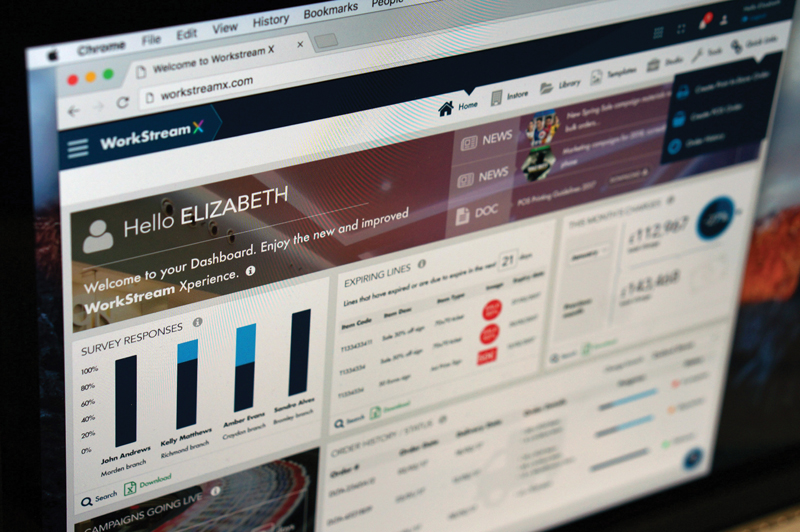
Good campaign management systems will intelligently drive in-store efficiency for marketers, helping both retailers and brands win at retail writes Niamh Higgins.
The common goal of marketing whether it’s digital, experiential, out of home or shopper is to reach consumers at the moments that most influence their decisions. Seeking the most efficient and cost-effective ways of getting products and promotional offers in front of consumers is a constant challenge. One that is no different when it comes to in-store activation. A further challenge comes in understanding how to achieve the greatest value from point of purchase displays (POP) and in-store print collateral.
Retail exists in an increasingly competitive environment where the world of the digitally connected shopper is ‘always on’. How important then is it to win at retail? The quoted “76% of all purchase decisions are made in store” and “68% of all in-store purchases are impulse driven” is familiar ground. Diving deeper, behaviours as cited by the OgilvyAction SDMIS study see almost 20% impulsively buying in categories they had no intention to buy from before entering the store to one in 10 shoppers switching brands when inside the store. For all these reasons and more, the power of the physical store is not yet diminished, it remains a significant touch point to reach and influence consumers. However, bricks and mortar retail has its work cut out to ensure the right impact in-store to win shopper’s attention in today’s omnichannel world. Apart from the typical competitive levers of price, range and service they must also now compete on shopping experience.
Creating a compelling and engaging experience in-store is crucial. It can go as far as to provoke positive emotional responses in the reward circuit of the brain cultivating propensity for preference and repetition. Shopper marketing has become an increased priority for FMCG organisations in the Irish market. Such investment has added stimulus to the in-store experience. Bringing with it greater acceptance that effective POP displays provide terrific opportunity to influence purchase decisions. After all, POP has been proven to yield sales lift as high as 200%. Balance this with a retailer’s own promotional activity to maximise basket size and value. Simply put, all of this effort means a lot of marketing euro is invested in store.
With investment comes risk. In this context, risk is going over budget, being left with excess collateral or worse still a shortage or wrong allocation, displays not fit for purpose or non-compliance. When multiple campaigns are run across multiple stores at once, specifications will undoubtedly differ, bringing complexity into the mix. For instance, at a basic level, printed collateral for a store in Belfast requires a different currency to be displayed to that of one in Cork. Failure to take this into account results in inefficiency – wasted materials incurring extra costs to replace, and potentially a damaged reputation for the brand who got it wrong for their consumers.
Investing in campaign management technology, specifically with store profiling capability, enables organisations to capture, organise and store data efficiently in real time, in one central location. Store profiling is an essential part of the retail future. Chiefly, it allows for the classification of key store attributes pertaining to store size, layout and location, technical specifications, display fixtures and merchandising considerations. A systematic approach replaces outmoded and complex allocation spread-sheets. An up-to-date and accurate profile of each store intelligently ensures the correct volume of an item is ordered at the time a campaign specification is built. Waste is reduced by only producing collateral that corresponds exactly to each store’s specification. No more blanket ordering due to a lack of readily available data to inform decisions. With a substantial proportion of POP material being thrown away unused or left in stock there’s clearly a need for greater control over processes and end-to-end visibility across campaigns. Quantity and right-fit cannot be let off the hook when seeking efficiency.
Campaign management technology can play a role in both head office and in-store environments. In-store integration allows for real demonstration of value. Store colleagues or franchisees can use the system to order print on demand collateral to support local and targeted marketing needs. Using pre-defined templates with online approval mechanisms ensures brand compliance. Materials can be ordered from stock or should POS arrive damaged, a retailer can simply request a replacement via the system. Intelligent store ordering permits only items that relate to each specific store profile to be ordered, greatly reducing waste.
At The Delta Group we believe such technology is an invaluable tool to today’s marketer, knowing first-hand the efficiencies delivered – efficiencies that can translate up to 30% cost savings. Additional functionality offers even more added value ranging from live tracking of store deliveries, hosting of merchandising plans, system alerts on campaign go-live or removal, to uploading activation photos and documenting compliance. Reduced complexity, greater accountability, transparency and control are engendered across the marketing value chain as a whole.
A one size fits all policy for POP programmes and POS collateral principally is a model that doesn’t work anymore. Maximising the opportunities that technological advances in campaign management offers, allows brand and retailer focus return to delivering the best possible experience in-store to the shopper. Retail and shopper marketing efforts can be effectively managed with an intelligence that considers channel, display and site specific requirements, ensuring efficient execution that enables winning at retail.
Niamh Higgins is commercial Director, Ireland with The Delta Group. In association with APMC.






















